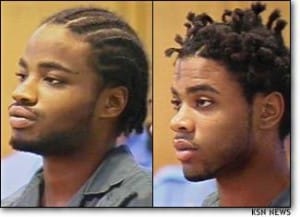WASHINGTON — Despite deep divisions over capital punishment, the Supreme Court ruled Wednesday that in the case of some particularly heinous Kansas murders, death was the appropriate penalty.
The court ruled 8-1 that death sentences handed down against three men in what became known as the “Wichita Massacre” in 2000 should not have been tossed out for procedural reasons by Kansas’ highest court. Justice Antonin Scalia wrote the decision, with Justice Sonia Sotomayor the lone dissenter.
So who committed the Wichita Massacre? Reginald and Jonathan Carr.
I’m not a rocket scientist, but people who look like this should not be allowed around civilized people. These guys have a feral look in their eyes.
So what did they do? According to Wikipedia:
The Carr brothers, 22-year-old Reginald and 20-year-old Jonathan, already had lengthy criminal records when they began their spree based on robbery. On December 8, 2000, having recently arrived in Wichita, they committed armed robbery against Andrew Schreiber, a 23-year-old assistant baseball coach. On December 11, three days later, they shot and mortally wounded 55-year-old cellist and librarian, Ann Walenta, as she tried to escape from them in her car; she died three days after the shooting.
Their crime spree culminated on December 14, when the Carrs invaded a home and subjected five young men and women to robbery, sexual abuse, and murder. The brothers broke into a house chosen nearly at random where Brad Heyka, Heather Muller, Aaron Sander, Jason Befort and his girlfriend, a young woman identified as ‘H.G.’, all in their twenties, were spending the night. They were all working adults: Befort was a local high school teacher; Heyka, a director of finance with a local financial services company; Muller, a local preschool teacher; and Sander, a former financial analyst who had been studying to become a priest. H.G. is a teacher.
The Carrs initially scoured the house for valuables. H.G. learned of Befort’s intent to propose marriage to her when the Carrs discovered the engagement ring he had hidden in a can of popcorn. After the search, the Carrs forced their hostages to strip naked, bound and detained them, and subjected them to various forms of sexual abuse, including rape and oral sex. The brothers forced the men to engage in sexual acts with the women, and the women with each other. They drove the victims to ATMs to empty their bank accounts, before taking them to a snowy deserted soccer complex on the outskirts of town. There they shot the five execution-style in the backs of their heads. The Carr brothers drove Befort’s truck over the bodies and left them for dead.
H.G. survived her head wound at the soccer field because her plastic barrette deflected the bullet. After the killers left, she walked naked for more than a mile in freezing weather to seek first aid and shelter at a house. Before getting medical treatment, she reported the incident and descriptions of her attackers to the couple who took her in, even before the police arrived.
The Carrs had returned to the friends’ house to ransack it for more valuables, and while there killed H.G.’s dog Nikki, which was muzzled. The next day the police captured the Carr brothers. Reginald was identified by both Schreiber and the dying Walenta. The District Attorney said that, based on evidence in the case, the Carrs’ motive was robbery.[1]
With the help of HG’s testimony at the trial, the Carr brothers were convicted of nearly all 113 counts against them, including kidnapping, robbery, rape, four counts of capital murder, and one count of first-degree murder. Reginald Carr was convicted of 50 counts and Jonathan Carr of 43.
If we can locate the genes of people likely to commit such rape, torture and murder, what should we do? How should society react to such people before they commit crimes?

